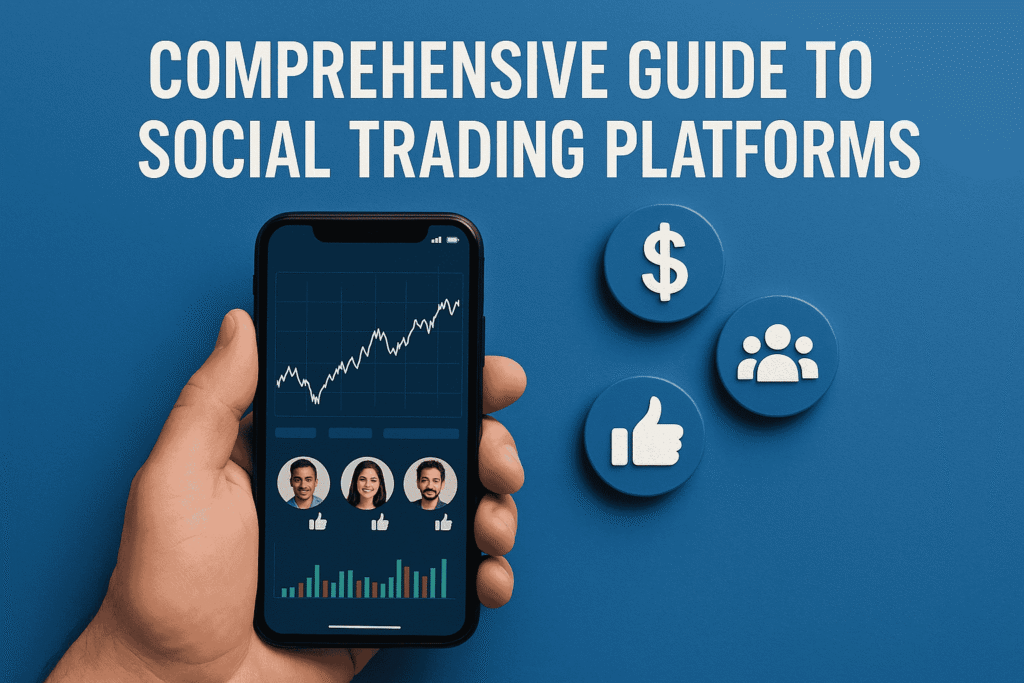
The trading landscape has evolved beyond traditional strategies. Today, investors no longer need to rely solely on their own analysis or financial advisors. The rise of social trading platforms has created a new way to participate in financial markets — one based on transparency, collaboration, and real-time information sharing. These platforms allow traders to connect, learn, and even replicate the trades of experienced investors automatically.
What Is a Social Trading Platform?
A social trading platform combines financial markets with social networking features. It allows traders to share strategies, performance results, and trading ideas in real time. More importantly, users can automatically copy trades from top-performing investors, a feature known as copy trading.
Platforms such as eToro, ZuluTrade, and NAGA have popularized this model, making forex, stocks, and crypto trading accessible even to beginners. Instead of studying complex indicators, users can follow experts and learn by observing their decision-making.
Visit Forex eBook Stores to find guides and resources that deepen your understanding of how these platforms operate and how to evaluate reliable traders.
How Social Trading Works
Social trading connects traders through a network where every transaction, strategy, and result can be analyzed. The basic process involves:
- Platform Registration: Traders create an account on a social trading platform.
- Strategy Browsing: They browse top-ranked investors based on verified performance data.
- Copying Trades: Once a trader is selected, followers can allocate funds to automatically mirror all trades executed by that expert.
- Monitoring Results: The follower’s portfolio updates in real time, showing gains or losses proportional to their investment size.
Each trade replicated in the follower’s account follows the same entry and exit points as the lead trader, ensuring accurate performance tracking.
Transparency as the Core Advantage
Unlike traditional fund management, social trading platforms display detailed historical data, risk scores, and drawdowns for each strategy. This transparency helps investors make informed choices about whom to follow.
Key Features of Modern Social Trading Platforms
1. Copy Trading
This feature allows users to replicate trades of top investors automatically. It is ideal for those who lack time or experience to analyze markets.
2. Community Insights
Traders can share opinions, market outlooks, and technical analysis directly on the platform. Discussions help build collective understanding and expose new opportunities.
3. Performance Analytics
Most platforms include dashboards showing win rates, risk ratios, and average trade durations. These metrics help followers choose reliable signal providers.
4. Diversification Tools
Users can follow multiple experts simultaneously to spread risk. By copying traders with different strategies — such as scalping, swing, and position trading — portfolios become more balanced.
5. Risk Controls
Social trading platforms include stop-copy features, allocation limits, and drawdown protection to safeguard against unexpected losses.
Benefits of Social Trading Platforms
- Accessibility: Beginners can start trading without deep technical knowledge.
- Learning Opportunity: Observing expert decisions teaches practical market behavior.
- Diversification: Following multiple traders reduces exposure to single-strategy risk.
- Community Support: Active discussions enhance confidence and knowledge sharing.
- Automation: The system manages trade execution, reducing manual errors.
Social trading democratizes financial participation. It gives new investors the ability to learn while earning, instead of waiting years to develop expertise.
Risks and Limitations
While powerful, social trading is not risk-free. Understanding its potential downsides is vital:
- Over-Reliance on Others: Copying traders blindly can lead to large losses if their strategies fail.
- Past Performance Bias: Historical profits don’t guarantee future success.
- High Volatility: Markets can shift quickly, and copying trades amplifies both wins and losses.
- Platform Reliability: Choose regulated brokers to ensure data accuracy and fund safety.
Education is key. Learn the fundamentals of risk management and position sizing at Forex eBook Stores before allocating real capital.
Types of Social Trading Models
Social trading platforms operate using different business models. Understanding these helps in choosing the right platform.
1. Copy Trading Networks
These focus purely on trade replication. Users allocate capital to copy specific traders, with performance mirrored automatically.
2. Signal Provider Platforms
Here, traders send trade signals manually, and followers decide whether to execute them. This allows greater control but requires user involvement.
3. Fund Management Platforms
Some platforms pool investor funds and assign them to expert managers. This model resembles traditional asset management but with greater transparency.
4. Hybrid Platforms
Modern systems integrate social feeds, analytics, and automatic trade execution in one interface — the best of all worlds.
Selecting the Right Social Trading Platform
When evaluating a platform, consider these factors:
Regulation and Security
Ensure the broker is licensed by recognized authorities such as FCA, ASIC, or CySEC. Regulation protects traders against fraud and ensures transparency.
Performance Verification
A credible platform displays verified historical data. Avoid platforms that hide losses or manipulate results.
Community Engagement
Strong forums and educational sections promote a healthy learning environment.
Copying Flexibility
Look for features like adjustable trade sizes, capital allocation controls, and risk limiters.
Fees and Spreads
Compare commission structures. Some platforms charge spreads, while others take a performance fee from copied traders.
A well-chosen platform balances accessibility, transparency, and risk protection.
How to Start Social Trading: Step-by-Step Guide
- Choose a Regulated Platform: Start with reputable platforms reviewed on Forex eBook Stores.
- Create an Account: Verify identity and deposit funds.
- Research Top Traders: Review risk levels, profitability, and consistency.
- Set Copy Parameters: Define the amount of capital to allocate and risk tolerance.
- Monitor Performance: Track your results weekly, adjusting exposure if needed.
- Review and Learn: Study copied trades to understand decision logic.
The best social traders use copy trading as an educational journey — not just a passive income source.
Best Practices for Successful Social Trading
1. Diversify Your Copy Portfolio
Follow traders using different timeframes and strategies. This minimizes correlation and stabilizes performance.
2. Track Risk Metrics
Always check maximum drawdown, risk scores, and average trade duration before following a trader.
3. Avoid Overtrading
Copying too many traders increases commission costs and complicates tracking.
4. Regularly Review Results
Reassess trader performance monthly. Replace underperformers and rebalance allocations.
5. Stay Educated
Use educational materials from Forex eBook Stores to strengthen understanding of forex fundamentals and behavioral finance.
How Social Trading Differs from Traditional Investing
Traditional investing relies on individual research or fund managers, while social trading allows collaborative decision-making. Key differences include:
| Aspect | Traditional Investing | Social Trading |
| Decision Source | Individual or advisor | Collective and transparent |
| Learning | Limited feedback loop | Real-time learning from peers |
| Automation | Manual trade execution | Auto-copy systems |
| Accessibility | Requires expertise | Beginner-friendly |
| Risk Sharing | Isolated | Distributed among multiple traders |
This structure creates an inclusive environment where even beginners can participate with confidence.
Impact of Social Trading on the Forex Industry
Social trading has reshaped forex trading by bridging the gap between technology and community learning. Brokers benefit from increased engagement, while traders enjoy transparency. The result is a dynamic ecosystem where data, strategy, and psychology converge.
Additionally, platforms now integrate AI analytics that identify top-performing traders automatically. This combination of technology and crowd wisdom has made social trading one of the most disruptive innovations in retail finance.
Challenges Facing Social Trading Platforms
Despite rapid growth, the industry faces obstacles:
- Regulatory Scrutiny: Authorities are developing stricter rules for investor protection.
- Data Privacy: Public performance data must remain secure.
- Sustainability: Platforms must ensure genuine user performance, not manipulated results.
- Overconfidence Among Followers: New traders often assume success without understanding risk.
To overcome these, platforms are introducing education-first approaches and advanced monitoring tools.
The Future of Social Trading
The next generation of platforms will combine AI with blockchain to improve transparency and reduce manipulation. Traders will be able to verify every copied trade through immutable records.
Social trading will also expand into decentralized finance (DeFi) and multi-asset portfolios, enabling investors to copy trades in crypto, forex, and stocks simultaneously. Community-driven governance models will allow users to vote on platform policies, creating a truly democratic trading ecosystem.
For forecasts and in-depth market insights, visit Forex eBook Stores — a reliable source for global trading trends.
Integrating Social Trading into Your Strategy
Social trading should complement, not replace, your personal analysis. Use it as part of a balanced approach:
- Combine copy trading with your own setups.
- Study each trader’s style to learn new tactics.
- Manage your capital allocation across several experts.
- Keep improving your independent analysis.
Over time, this hybrid approach helps you grow from a passive follower into a confident, self-sufficient trader.
Conclusion
Social trading platforms are revolutionizing how people invest and learn. They merge transparency, automation, and community — giving beginners a structured path into financial markets. While they don’t eliminate risk, they make trading more accessible and educational.
The key to success lies in responsibility: follow verified traders, manage risk actively, and stay engaged in the learning process. The blend of human insight and technology makes social trading one of the most promising innovations in modern finance.
For educational guides, platform comparisons, and practical tutorials, explore Forex eBook Stores — your trusted resource for mastering the evolving world of online investing.
